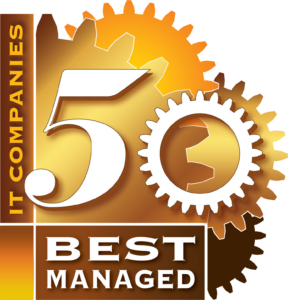
Digital Transformation Solutions That Will Help Your Company Grow
Digital Transformation Solutions That Will Help Your Company Grow
There are a lot of unexplored possibilities for small- and medium-sized organizations to undergo a digital transformation.
One of the trends we see today is organizations looking for ways to leverage their technology more effectively.
Our clients want a digital transformation, which, for us, starts with looking at the internal functions and processes within an organization. And then looking at what technologies are available, be either hardware or software, to help automate or help increase the throughput on those processes.
In short, we’re transitioning processes from manual to digital wherever possible to gain benefit.
There’s a major focus on digital transformations right now because most CEOs or senior executives are aware that “better” is out there. They’re just not sure exactly what better looks like.
To gain those efficiencies that every business needs to be striving towards, you really have to know how to apply technology to your business processes. It’s the easiest way to make a transformative change in your business.
Where to Start Your Digital Transformation
If you aren’t really sure how to go about leveraging technology, you need to start by having a conversation with someone who has both a technology and a business background.
This should be a big-picture discussion. For example, what parts of your organization can be automated? Because if you’re not sure what’s out there, it’s difficult to understand how much work is involved in changing your business.
A lot of CEOs know that better is out there. But they need someone with that IT and business experience to match the business goals to the technology that’s available to reach those goals.
It’s safe to say that there’s a lot of organizations that could be leveraging technology much more than they are.
We see that regularly as we talk to different organizations. A lot of people just don’t know what’s possible, and when you start looking at what’s possible, it’s amazing what can be done.
The conversations usually start with something like, “Did you know that this can be done in a certain way using leveraging technology to make a part of the business grow faster?” And that usually snowballs into a “What else can we do?” And the reality is, almost everything.
Leveraging Technology Effectively
Technology can have an impact on every aspect of the businesses that these CEOs are running.
Once the discussion begins, it usually snowballs and builds its own inertia. Eventually, the CEOs say, “Let’s look at everything. There’s gotta be a better way to do it all.”
The good news is that that’s almost always the case. There is a better way to perform most of the functions that are currently performed manually in your organization.
Documenting Workflows
Before we even consider what processes we can automate, the big deliverables for a digital transformation start with streamlining workflows.
If you don’t have documented processes, or know how information flows through your business now, or how people interact, you can’t automate anything, because no one is clear about your operations.
A lot of the benefits at the beginning stages of a digital transformation come from forcing business owners to actually document the way things work now.
A lot of times during that process, weaknesses just materialize because there’s a spotlight on them. Once you see how things are working now, you’ll have that understanding of exactly who does what and how information moves.
Automating Processes
Process automation is the next step. Once we understand the way the processes work, we can find ways to automate them.
Then you can look at the tools you need. And you can determine the process changes that you need to make something that took two hours a day, for example, take five minutes a day.
Tying Systems Together
The next step is tying systems together.
Again, now we have documented and streamlined workflows, and we’ve identified areas that we can automate. At this point, we look at what tools you’re currently using, and the tools that are available.
You may have disparate systems that solve parts of a problem. We try and get them down to the most concise group of tools that we can use to make the transition as easy as possible. That also makes it easier to ensure that all of the systems are talking to each other.
What Does Digital Transformation Look Like in an Organization?
We work with a lot of different organizations, but here’s a specific example of something that we’ve done with one of our client organizations.
We had a client still using very manual processes. They literally had invoices stuck on those little paper invoice pads and sent pieces of paper down to the accounting office to have them manually key orders in.
We took them to a completely automated cloud system. Now, the driver in a truck that’s doing deliveries updates where he is when the delivery is made, and the customer is billed automatically. When the billing goes through and the payment is made, the order closes automatically.
In some cases, it’s pretty easy to take a very manual process and revolutionize it to the point where it’s unrecognizable in terms of how the digital transformation affects the business.
In a scenario like that, you can eliminate so many manual processes. And the goal of eliminating those processes is to deliver goods and services to your customers in a much more efficient and streamlined manner.
Benefits of Digital Transformation Solutions
For business leaders, the benefits of leveraging technology start with the cost benefits.
Manual processes obviously have costs associated with them. Any time that we can avoid a manual process, we’re reducing a cost.
Also, and equally important, if we’re delivering services more effectively from the customer’s perspective, then the internal digital transformation will be apparent to your client base or customer base immediately.
They see that things happen faster and more accurately. There are fewer headaches. And they don’t have to invest as much energy from their own staff in working with you as a customer.
The benefits just ripple through an organization. The most important thing for most businesses that go through a digital transformation is they’re delivering significantly better services to their clients, and they’re spending less money to deliver those significantly better services.
The CopperTree Approach to Leveraging Technology
At CopperTree, the digital transformation conversation happens as a part of our vCIO process.
On a day-to-day basis, we guide our clients through that process. It typically begins with us identifying a manual process within an organization, or the client coming to us and saying, “There’s gotta be a better way to do this. I have no idea what it is, but there must be a better way to do it.”
That’s an indicator for our vCIO to look at the workflow they’re trying to solve or automate and make recommendations. Usually, that includes a tool that will solve the problem.
The vCIO also makes sure that the work involved is clear, and that the benefit obviously is very clear as well.
The engagement usually begins with something as simple as maybe “I need a better time clock.” Maybe it’s too much work for payroll to keep track of everybody’s in-and-outs through our building and you want to automate your time clock process.
That can lead to a new time clock system. But while you’re at it, the time clock feeds data into your accounting system. And there are inefficiencies there that we can work on too.
That leads to how you’re analyzing the time clock data, and how that interacts with your manufacturing process. And it kind of snowballs.
A Larger Discussion
You end up realizing that what began as a discussion about a time clock really is a discussion about all of the upstream and downstream functions that happen after that time clock and what’s related to it.
And that usually opens a larger discussion around all of the other things that the client does manually. And they realize that if the time clock situation was that easy to fix, then there are a boatload of other components that can be made significantly more efficient by the same process.
Ultimately, it’s all about solving business problems. We often tell clients not to tell us what they think the solution might be. Just tell us what the business problem is, and we’ll figure out the technology solution to solve that problem.
Business leaders who try to preemptively guess what the answers will be are boxing themselves in before the conversation even starts.
The best thing is to share that original “a-ha” moment with us directly. For example, “it has to be faster to go from an order to production. I have no idea how, but it has to be faster because we’re very manual.” And then leave the work of understanding how that works to us. We’ll recommend the right tools to make that process better.
You’re the expert on how your business operates, and you know what result you need from any change that we initiate. It’s our job to make technology recommendations based on the results you want and the processes you have.
Focus on the Business Benefits of Digital Transformation
Also when we come back with those technology recommendations, we can have a conversation that focuses on the business benefits. You can understand the work and the costs involved more clearly and make a business decision. When you know that a specific cost will give you a specific result, you can make a better decision.
Again, however, it really starts with understanding your business. We need to understand your processes and workflows to leverage technology and increase automation. But the end result is better visibility. You also have better data to make decisions and spend less time on manual workflows in your organization.
If you keep the results that you’re looking for clearly in mind, then the whole process tends to be much more beneficial for the organization. “What are we trying to do from a business perspective?” is the mantra all the way through the process.
Are we doing things for the sake of doing them, or are we doing them to produce the business goals that have nothing to do with technology? Because technology is just the tool.
Are we laser-focused on the business goals? Because if we’re making a process faster, cheaper, or easier to execute, the technology we implement will have to drive that.
Are you interested in the possibilities of digital transformation for your organization? Click here to start a conversation with CopperTree today!



